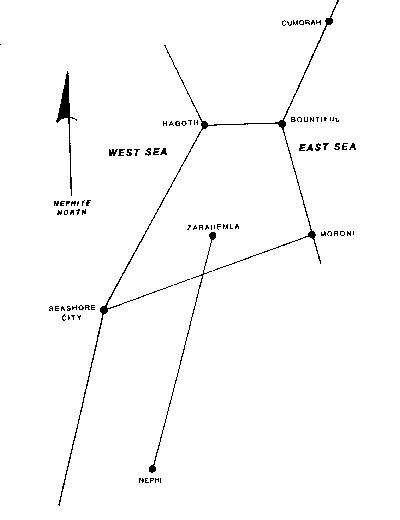Índice
NEEDS TRANSLATION
Question: What are the essential features of a valid Book of Mormon geography?
Ten essential features of geography
Author John Clark prepared a list of ten key elements which the Book of Mormon text requires for its geography. Any model can be checked against these textual requirements to assess its plausibility:
- A narrow neck (isthmus) separated the land northward from the land southward and was flanked by an east sea and a west sea.
- Nephite and Lamanite lands occupied at least three times as much western coastline as eastern coastline.
- The eastern wilderness was much wider and lower than the western wilderness but not nearly as wide as the southern wilderness.
- The city of Nephi was in a highland valley; Zarahemla was in a large river basin.
- The river Sidon flowed northward through Zarahemla.
- The Waters of Mormon was probably a highland lake of significant size.
- Zarahemla was surrounded by Nephite fortifications.
- The city of Nephi was three weeks’ travel south from Zarahemla and near the Waters of Mormon.
- The city of Bountiful was north of Zarahemla and near the narrow neck; it was about five days’ travel from Moroni and guarded the route to the land northward.
- Cumorah (also called Ramah) was near the eastern sea, not very far north of Bountiful.[1]

Figure 2:Essential relationship between Book of Mormon lands, from Clark.
[2] Cultural features
Archaeology does not directly impact the building of a Book of Mormon geography, but it can act as a check on a model. Models that place the Book of Mormon in areas which are archaeologically consistent with the Book of Mormon story are more likely to be correct than those which have little archaeological support. Archaeological science is imperfect, of course, and new discoveries can overturn old certitudes. However, a model which matches both geographic and cultural clues gives us greater confidence in its accuracy.
Palmer notes that the following are all cultural aspects of the Book of Mormon account:
- cities
- towers
- agriculture
- metallurgy
- formal political states
- organized religion
- idolatry
- crafts
- trade
- writing
- weaponry
- astronomy
- calendar systems
- cement
- wheels[3]
While it is certainly true that Palmer's criteria for the Book of Mormon Cultures apply to the Land Southward cultures under the neck of land, there are skeptical alternate views with regards to whether they apply to the region of Cumorah or not. Those views argue that if there is a northern domain that is far removed from the central urban southern domain, it is not necessary to expect the same archaeological criteria for that northern domain necessarily.
Notas
- ↑ John E. Clark, "A Key for Evaluating Nephite Geographies (Review of Deciphering the Geography of the Book of Mormon by F. Richard Hauck)," FARMS Review of Books 1/1 (1989): 20–70. off-site; summarized by John W. Welch and J. Gregory Welch, Charting the Book of Mormon: Visual Aids for Personal Study and Teaching (Provo, Utah: FARMS and Institute for the Study and Preservation of Ancient Texts, 1999), chart 149. ISBN 0934893403. (Permission in digital version granted for non-profit reproduction and distribution if copyright notice intact and material unaltered.)
- ↑ From John E. Clark, "A Key for Evaluating Nephite Geographies (Review of Deciphering the Geography of the Book of Mormon by F. Richard Hauck)," FARMS Review of Books 1/1 (1989): 20–70. off-site; Figure 2 off-site
- ↑ David A. Palmer, "Review of The Land of the Nephites by Delbert W. Curtis," FARMS Review of Books 2/1 (1990): 67–73. off-site


